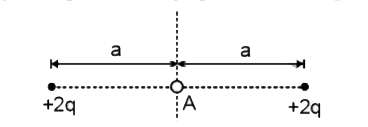The Electric field at a point is
A. always continuous
B. continuous if ther is no charge at that point.
C. discontinuous only if there is a negative charge at that point.
D. discontinuous if there is a charge at that point.
A,C are true
All are true
B,D are true
B,C are true
The correct Answer is:C
To solve the question about the continuity of the electric field at a point, let's analyze the options step by step.
Step 1: Understanding Electric Field Continuity
The electric field at a point is defined by the behavior of electric field lines. These lines represent the direction and strength of the electric field. A key property of electric field lines is that they cannot cross each other; at any given point in space, the electric field can only have one direction and one magnitude.
Step 2: Analyzing the Options
- Option A: Always continuous
- This option suggests that the electric field is always continuous at any point. However, this is not true because the presence of a charge can cause discontinuities in the electric field. Therefore, this option is incorrect.
- Option B: Continuous if there is no charge at that point
- This option states that the electric field is continuous if there is no charge at that point. This is true because if there are no charges present, the electric field lines can extend freely without interruption. Thus, this option is correct.
- Option C: Discontinuous only if there is a negative charge at that point
- This option implies that the electric field is discontinuous only when a negative charge is present. However, the presence of any charge (positive or negative) can cause the electric field to be discontinuous. Therefore, this option is incorrect.
- Option D: Discontinuous if there is a charge at that point
- This option states that the electric field is discontinuous if there is any charge at that point. This is true because the presence of a charge (whether positive or negative) can cause the electric field lines to terminate or change direction, leading to discontinuity. Thus, this option is correct.
Step 3: Conclusion
Based on the analysis, the correct answers are Option B and Option D. The electric field is continuous if there is no charge at that point and discontinuous if there is any charge at that point.
Final Answer
The correct options are B and D.
---
The electric field at a point is defined by the behavior of electric field lines. These lines represent the direction and strength of the electric field. A key property of electric field lines is that they cannot cross each other; at any given point in space, the electric field can only have one direction and one magnitude.
- Option A: Always continuous
- This option suggests that the electric field is always continuous at any point. However, this is not true because the presence of a charge can cause discontinuities in the electric field. Therefore, this option is incorrect.
- This option states that the electric field is continuous if there is no charge at that point. This is true because if there are no charges present, the electric field lines can extend freely without interruption. Thus, this option is correct.
- This option implies that the electric field is discontinuous only when a negative charge is present. However, the presence of any charge (positive or negative) can cause the electric field to be discontinuous. Therefore, this option is incorrect.
- This option states that the electric field is discontinuous if there is any charge at that point. This is true because the presence of a charge (whether positive or negative) can cause the electric field lines to terminate or change direction, leading to discontinuity. Thus, this option is correct.
Based on the analysis, the correct answers are Option B and Option D. The electric field is continuous if there is no charge at that point and discontinuous if there is any charge at that point.
The correct options are B and D.
Topper's Solved these Questions
- BOOK - NARAYNACHAPTER - ELECTRIC CHARGES AND FIELDSEXERCISE - EXERCISE -2 (H.W)36videos
ELECTRIC CHARGES AND FIELDS
- BOOK - NARAYNACHAPTER - ELECTRIC CHARGES AND FIELDSEXERCISE - EXERCISE -350videos
ELECTRIC CHARGES AND FIELDS
- BOOK - NARAYNACHAPTER - ELECTRIC CHARGES AND FIELDSEXERCISE - EXERCISE -1 (H.W)27videos
ELECTRIC CHARGES AND FIELDS
- BOOK - NARAYNACHAPTER - DUAL NATUREEXERCISE - LEVEL-II (H.W)17videos
DUAL NATURE
- BOOK - NARAYNACHAPTER - ELECTRO MAGNETIC INDUCTIONEXERCISE - Level-II (H.W)23videos
ELECTRO MAGNETIC INDUCTION
Similar Questions
Knowledge Check
- Question 1 - Select One
A negative point charge placed at the point A is
 Ain stable equilibrium along x-axisBin unstable equilibrium along y-axisCin stable equilibrium along y-axisDin unstable equilibrium along x-axis
Ain stable equilibrium along x-axisBin unstable equilibrium along y-axisCin stable equilibrium along y-axisDin unstable equilibrium along x-axis - Question 2 - Select One
The electric field created by a point charge falls with distance r from the point charge as
A1rB1r2C1r3D1r4 - Question 3 - Select One
The points of discontinuity of tan x are
Anπ,n∈IB2nπ,n∈IC(2n+1)π2,n∈IDNone of the above
We know that electric field is discontinuous across the surface of a charged conductor. Is electric potential also discontinuous there?
View SolutionWe know that electric field is discontinuous across the surface of a charged conductor. Is electric potential also discontinuous there?
View SolutionThe electric field of a point charge is uniform. Is it true or false?
View SolutionElectric lines of force about negative point charge are
View SolutionElectric lines of force about negative point charge are
View Solution


